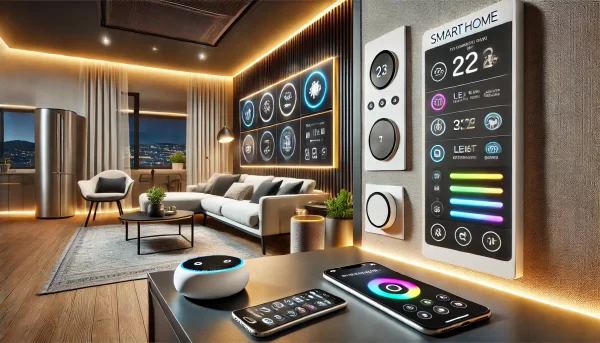
Smart home upgrades are transforming the way we interact with our living spaces, offering enhanced convenience, improved energy efficiency, and increased security. Automation and control systems allow homeowners to manage lighting, climate, security, and appliances through smartphones, voice commands, or central control hubs. As smart technology continues to evolve, integrating these systems into your home has never been more accessible or beneficial.
This article explores the key components of smart home upgrades, the benefits they offer, and how to plan and implement them effectively.
What Are Smart Home Automation and Control Systems?
Smart home automation involves using technology to control and automate various functions within your home. These systems include lighting, heating and cooling, security, and entertainment. With centralized control through apps or voice assistants, homeowners can customize their living spaces to fit their routines and preferences.
Control systems, such as hubs or apps, connect all smart devices, allowing seamless interaction between different components. For example, your smart thermostat can adjust the temperature based on whether your security system detects you leaving or arriving home. This integration not only enhances convenience but also optimizes energy use and safety.
Benefits of Smart Home Upgrades
Enhanced Convenience and Customization
Smart home systems allow you to control various aspects of your home from a single device, such as a smartphone or tablet. Features like scheduled lighting, remote access, and programmable thermostats make daily tasks easier and more intuitive. Customization options ensure that your home’s functionality aligns perfectly with your lifestyle.
For example, automated lighting can adjust based on the time of day or your activity, creating a comfortable ambiance without manual adjustments.
Improved Energy Efficiency
Smart devices are designed to optimize energy use, reducing waste and lowering utility bills. Smart thermostats learn your temperature preferences and adjust accordingly, while smart lighting systems automatically turn off lights in unoccupied rooms. These technologies work together to create an energy-efficient home that aligns with sustainable living goals.
Energy efficiency is especially important when designing homes from scratch. Including smart systems during electrical planning for new builds ensures that your home is both future-ready and cost-effective.
Increased Security
Security is a top priority for many homeowners, and smart systems offer advanced solutions to protect your property. Smart locks, doorbell cameras, and motion sensors provide real-time alerts and remote access, giving you peace of mind whether you’re at home or away. Integration with other systems, such as lighting or alarms, enhances security by creating visible deterrents for intruders.
Key Components of Smart Home Systems
Smart Lighting
Smart lighting systems provide more than just illumination. These systems allow you to control brightness, color, and schedules with ease. They can also integrate with voice assistants, enabling hands-free operation. Whether it’s dimming the lights for a movie night or automating outdoor lighting for security, smart lighting adds both functionality and aesthetic appeal.
Smart Thermostats
A smart thermostat learns your habits and adjusts the temperature to maintain comfort while saving energy. With remote access, you can control your home’s climate from anywhere, ensuring energy efficiency even when you’re not home.
Home Security Systems
Smart security systems include features such as video doorbells, motion detectors, and cameras. These devices provide live feeds and alerts to your smartphone, allowing you to monitor your property in real-time. Some systems also include integration with local emergency services for added protection.
Smart Appliances
Smart refrigerators, ovens, and washing machines offer features like remote operation and energy monitoring. These appliances simplify household tasks while optimizing resource use, making them a valuable addition to any smart home.
Planning for Smart Home Upgrades
Evaluating Your Needs
Before diving into smart home upgrades, assess your needs and priorities. Determine which areas of your home would benefit most from automation, such as lighting, climate control, or security. Consider your lifestyle and how smart systems can enhance it.
Electrical Planning
Proper electrical planning is critical when integrating smart home systems. Many smart devices require dedicated outlets, wiring, or network infrastructure. Including these elements during construction or renovation ensures seamless integration of smart technologies. For new builds, incorporating smart systems during the electrical planning process allows for a more cohesive and cost-effective installation.
Choosing the Right Systems
With a wide range of smart devices available, selecting the right ones for your home is essential. Look for systems that are compatible with each other and can be controlled from a single app or hub. Opt for devices with high energy efficiency ratings to maximize savings.
Implementing Smart Home Technology
Professional Installation
While some smart devices are easy to install, more complex systems, such as smart lighting or security networks, may require professional assistance. Licensed electricians ensure that your electrical infrastructure supports the demands of smart devices and complies with safety standards.
Integration and Testing
Once installed, test your smart systems to ensure they function as intended. Configure settings such as schedules, notifications, and automation triggers to customize the experience. Regular updates and maintenance keep your system running smoothly and securely.
Future-Proofing Your Smart Home
Smart home technology is constantly evolving, making future-proofing an important consideration. Choose systems that can be updated or expanded as new technologies emerge. This includes ensuring your electrical system can accommodate additional devices or higher power demands in the future.
Conclusion
Smart home upgrades, including automation and control systems, offer unparalleled convenience, efficiency, and security. From lighting and climate control to advanced security features, these systems transform homes into modern, responsive spaces tailored to your needs. By carefully planning your upgrades and working with professionals, you can create a smart home that enhances your lifestyle and adds long-term value to your property.
Incorporating smart systems during the electrical planning phase ensures seamless integration and prepares your home for the future. Whether you’re upgrading an existing space or designing a new one, smart home automation is a worthwhile investment in comfort and innovation.
